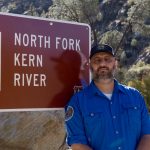André Sanchez
California
This interview was conducted by Carly Schmidt on October 26, 2021. Photo by Matthew Falcon. Learn more about André’s work at https://www.calwild.org/.
Transcript
What does it mean to be the first San Joaquin Valley Organizer at California Wilderness Coalition?
I got started with CalWild in early 2020, just a couple weeks before everything shut down due to the COVID-19 pandemic. CalWild was looking for someone with close ties to the San Joaquin Valley, who would help activate the diverse local community to advocate for public lands, and who would reside in the Valley and I met all criteria. I was also looking for an opportunity to expand my repertoire of experience related to conservation work. Previously, I had been doing hands-on wildlife and conservation work, particularly around aquatic ecosystems. Adding to that, when I applied with CalWild, I was wrapping up working on a seasonal aquatic wildlife crew in Yosemite National Park, my fourth (non-consecutive) season doing so and my first season serving in a leadership role as a crew lead. This position with CalWild was really an opportunity to come back home and engage with my community in a totally different way. All that said, my role with CalWild is working towards getting the diverse local community to really engage in public lands advocacy and help change who is at the table when talking about protecting natural resources and landscapes.
What are your current priorities at CalWild?
At the organizational level, some of our largest active projects right now are related to three wilderness bills that include stream mileage being added to the Wild & Scenic Rivers system. We’re working on the Northwest California Bill, the Central Coast Bill, and the San Gabriel Mountains Bill. These projects each have different streams that are eligible for Wild & Scenic designation. The three different bills made it through the House of Representatives earlier this year and recently, the PUBLIC Lands Act (the Senate bill that includes the three wilderness bills and is championed by Senator Alex Padilla) had a Senate committee hearing.
More locally, I’m working in the southern Sierra Nevada in the Sequoia and Sierra National Forests. Both forests are undergoing their forest management plan revisions, which will inform their guidance for the next 10 to 15 years. We’re urging the U.S. Forest Service to increase the Wild & Scenic River mileage that would be eligible for such protections. Locally and overall in the organization, we are actively trying to make equity and access a priority in our work around public lands, whether that be the work we have engaged in so far around the conservation goal of protecting 30% of lands and waters by the year 2030 (30 by 30) or the Forest Management Plans.
How has the Wild & Scenic Rivers Coalition helped you with these efforts to expand mileage for certain rivers and streams?
This group has been incredibly supportive, especially KB (Katherine Baer) at River Network. A great connection that came out of the Wild & Scenic group was the rivers stewardship grant opportunity through River Network. CalWild is using that grant to do some work on the Merced River, which already has a Wild & Scenic designation.
Well before that opportunity, I flew out to Washington, DC, in early 2020 and was immediately introduced to active advocacy and lobbying. I was grateful that I got to dive into that work right off the bat with some amazing individuals from the Coalition. It was a huge learning moment for me. All the groundwork happens locally, but it’s ultimately the goal to get out there and make our case to representatives and get their support on different bills. The fearless leader of the Coalition, Lisa Ronald, facilitates our annual meeting and helps us put together coalition letters and leads meetings in the meantime. We keep each other informed on local or statewide developments that could impact all of us. Keeping in the know about opportunities and information is the biggest benefit.
In the short time you’ve worked with the Wild & Scenic Rivers Coalition, what are your most impactful learnings?
The first thing I noticed when we met in-person in 2020 was how well prepared everyone was. They could speak the language of rivers very readily and it was such a natural conversation. Some of these folks have been doing this work for decades or longer. One of my mentors is Steve Evans, who has been a California rivers advocate for over 35 years. I learned so much from shadowing him, especially in terms of approaching these meetings and how to adapt when someone throws you a wrench. I feel fortunate to have a personality that lends itself to this kind of advocacy work, and I’ve learned how important it is to be personable and friendly with the different personnel you’re meeting with.
How do you and the CalWild team stay motivated to do this intense and often slow-moving work?
California is now the first state to commit to the 30 by 30 initiative (the goal of conserving at least 30% of lands and waters by the year 2030); per an Executive Order from President Biden, the United States is committed to meeting a similar goal at the federal level. The California goal set by Governor Newsom created a new urgency around creating coalitions in regions throughout the state and urging the state agencies to support protections on federal lands. It is an incredible amount of work that needs to be done, but it’s really inspiring to see all these allies come together and take an active lead.
I am one of the leads here in the San Joaquin Valley, but there isn’t too much public land out here on the valley floor. People around here recreate up into the Sierra Nevada and the coast range. There is a lot of work to be done and it does seem overwhelming at times, but there is also hope because there’s a lot of potential here. It leads me to ask, Why can’t we eventually add a Wild & Scenic River designation on the valley floor? As a whole, meeting awesome people who are willing to collaborate on restoration and environmental justice issues has provided me with a new way of re-energizing.
You mentioned the 30 by 30 initiative. How are you approaching this goal-setting both at CalWild and with other partner organizations?
At the organizational level, we’re changing where we’re working and how we’re operating. We’re in the strategic planning process and trying to define where we are and where we should go in the future. A lot of these answers are already defined in the 30 by 30 objectives. We’re realizing that we need to work more on the state (as opposed to just the federal) level if we want to have a more significant impact on long-term forest management, Wild & Scenic River designation, and other protections of lands and waters.
On a more personal level, I’m hoping that we continue to incorporate other elements that are currently somewhat on the sidelines of our objectives. I like to operate on a watershed or macro-scale as much as I can, and that includes recognizing where intersectionality shows up. I am invested in CalWild’s equity, access, and inclusion work, particularly in terms of increasing access to federally managed land. I’ve had a lot of support from CalWild as I try to be one of the voices bringing up the issue within the Wild & Scenic Rivers Coalition and in other spaces, highlighting that we as an organization are working to do better with all conservation efforts we are involved in.
What advice would you give to other advocates looking to speak up for inclusion and access on federally-managed lands?
Look for opportunities to engage. For example, the Department of the Interior is hosting listening sessions on equity and access. Pursue those opportunities and look for ways to incorporate lessons learned into your own work. Also recognize that you, as a person within an organization, are not necessarily equipped to solve all the world’s problems, but we can all strive to stay involved and in the know at the very least. We can and should strive to expand how we’ve traditionally approached conservation.
Also, reach out by partnering with other organizations. I am one of the regional program coordinators for Latino Outdoors’s Fresno chapter. I love how as an organization, Latino Outdoors works at the community level but has also transitioned to work on policy issues that no organization has tapped into before. Overall, I urge folks to continue to build relationships, especially with communities that have historically been excluded from these conversations.
What formative experiences led you to your current drive toward environmental stewardship and organizing?
The novel Hatchet by Gary Paulson left a significant mark on my mind and soul. The main character is on a journey to see his father and his plane crashes and his only tool for survival is this hatchet. This kid has to learn to tend to the land and have the land tend to him, and that spoke to me in many different ways. The author just passed away, which made me realize the impact of that book.
I also grew up fishing with family and friends when I was young. I tagged along with my older brother and his friend and I realized that I wanted to be outside. Just the joy of realizing that you are in this beautiful place, as part of the landscape and fishing for resources in these rural places along the San Joaquin River was really formative. Earlier than that and the most formative of all, is the experience of my late uncle taking my siblings and I to Yosemite when we were really young and I have such vivid memories of that place and time. Adding to my memories in the park, I ended up working for the concessions company and living in Yosemite right after high school, which was also the summer before I began college and arguably needed to find my life path. Residing there furthered my love of the Park and made me want to go back there to work and help protect the place I long loved. Things aligned for me and I eventually got an internship with the National Park Service doing restoration work, so it all came full circle and it was a dream come true.
How was the transition from fieldwork to advocacy work and what advice would you give to someone else wanting to make the same transition?
Coming into this advocacy and organizing work wasn’t necessarily intuitive, but personality is a big part of success in this role. Becoming a front-facing figure for both the community and local elected officials was a learning curve. But my previous experience at Latino Outdoors—getting groups of people out in nature together—definitely helped. Some of that knowledge was already there to some degree, but understanding and engaging in the policy side did initially feel a bit challenging. It was so helpful to have the support of staff at CalWild, most of whom have been doing this work for many years.
When I was first getting started, I had to get comfortable with not knowing all the answers. I was the point person in a few groups and I had to get comfortable saying, “I’ll learn the answer and get back to you.” And sometimes finding the right answer requires a bit of work. Learning when to say “I don’t know,” is still a very useful skill in this work. To more generally answer the question for folks who might be transitioning from fieldwork to advocacy, I would say share the love of places that you helped steward and seek out ways to engage in advocacy opportunities, especially for your local places and your beloved places. Doing so might lead you to an opportunity that lets you combine it all.
About
Growing up in the heart of the San Joaquin Valley, André was raised in the agriculturally fueled town of Madera, CA. A community where working the land was the norm and recreating in nature seemed foreign to most members of his community. Fortunately for André, one of his uncles discovered the joys of recreating outdoors and shared the discovery with André’s family, ultimately instilling a passion for conservation and restoration work. After receiving a B.S. in Wildlife, Fish, and Conservation Biology from UC Davis in 2014, André went on to work for several state and federal agencies, including conducting aquatic restoration in Yosemite National Park. After gaining perspective from his work experiences, André returned to academia to pursue an M.S. in Natural Resources with a Watershed Management emphasis at Humboldt State University. André is additionally involved with Latino Outdoors, a latinx-led organization that connects and engages leaders and community members in the outdoor, conservation, and nature movement. As CalWild’s San Joaquin Valley Organizer, André is excited to see public lands advocated for and protected, especially those that inspired him and provide ecosystem services for his community. André now resides back in the San Joaquin Valley and loves to recreate outdoors via backpacking, hiking, rock climbing, or simply observing the raw beauty that nature delivers.







